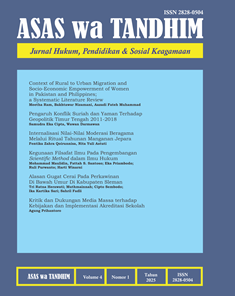Context of Rural to Urban Migration and Socio-Economic Empowerment of Women in Pakistan and Philippines; a Systematic Literature Review
DOI:
https://doi.org/10.47200/awtjhpsa.v4i1.2568Keywords:
Migration, Rural, Urban, Socio-Economic, Women EmpowermentAbstract
The movement of people from rural areas towards urban units is understood as rural-to-urban migration. Women empowerment is the process that leads women to ownership of resources, improves their ability to control their lives and families, and allows them to make decisions to develop new strategies in life. The rural-to-urban migration in Pakistan changes the socioeconomic status of women through their engagements in formal job markets and increases earning sources through paid or professional work. In the Philippines, the economic driver is one of the primary and dominant forces for rural-to-urban migration. This study aimed to assess the impacts of migration on women’s socio-economic status. Also, it focused on exploring migration trends and women’s engagement in the labour market after migration in both countries.
Downloads
References
AF, A. F., January 2011. Women’s Empowerment in Pakistan - A Scoping Study, s.l.: Aurat Publication and Information Services Foundation.
Anderson, K., Apland, K., Dunaiski, M. & Yarrow, E., 2017. Women in the Wind; Analysis of Migration, Youth Economic Empowerment and Gender in Vietnam and in the Philippines, Plan International.
Arif, GM & Hammid, 2007. Gender Dimensions in Rural-Urban Migration in Pakistan. Islamabad.
Asia and Pacific Regional Bureau for Education, U. B., 2018. Policy Briefs on Internal Migration in Southeast Asia, Bangkok: Asia and Pacific Regional Bureau for Education, UNESCO.
Aziz, G., 2014. Migration and Women Empowerment. Islamabad, Quaid-i-Azam University Islamabad, pp. 73-73.
Basa, C. & Villamil, L., 2009. Migration, local development and governance in small towns: two examples from the Philippines, London: International Institute for Environment and Development (IIED).
Blank, J., Clary, C. & Nichiporuk, B., n.d. Drivers of Long-Term Insecurity and Instability in Pakistan, RAND Corporation.
Chant, S., 2013. Cities through a “gender lens”: a golden “urban age” for women in the global South? Environment and Urbanization, Volume 25 (1), pp. 9-29.
Deshingkar, P. & Anderson, E., June 2004. People on the move: New policy challenges for increasingly mobile populations. Natural Resource Perspectives. Number 92.
Farooq, M. & Cheema, M. A., 2005. Likelihood Impact of Internal Migration on Family Institution in Punjab, Pakistan. Journal of Agriculture and Social Sciences, p. 148–151.
Fischer, R., 2009. Rural-Urban Migration. A necessity to survive - Term Paper. Munich, GRIN Verlag, p. 12 Pages.
Government of Pakistan, P. C., 2005. Planning Commission, Government of Pakistan.
Helbock & Richard, W., 1975. Differential Urban Growth and Distance Considerations in Domestic Migration Flows in Pakistan. The Pakistan Development Review 14:1.
Irfan, M., Demery, L. & Arif, G., 1983. Migration Pattern in Pakistan: Preliminary Results. Studies in Population, Labour Force, and Migration, Islamabad: Pakistan Institute of Development Economics.
Kabeer, N., 2001. Reflections on the measurement of women's empowerment. Swedish International Development Cooperation Agency, Stockholm, Sweden, pp. 17-57.
Labour Force Survey 2017-18, 2018. Labour Force Survey 2017-18, Islamabad: Pakistan Bureau of Statistics, Government of Pakistan.
Mahmud, M., Musaddiq, T. & Said, F., 2010. Internal Migration Patterns in Pakistan; The Case for Fiscal Decentralisation. The Pakistan Development Review, p. 593–607.
Malhotra, A., Schuler, S. R. & Carol, B., 2002. Measuring Women’s Empowerment as a Variable in International Development: Gender and Development Group of the World Bank.
Malik, A. S., 2015. Rural Urban Migration; Socio-Cultural Challenges in Pakistan – Preventative measures taken by Government and civil society to control it. The Professional Medical Journal 22(6), pp. 674-682.
Manzoor, U. & Idress, B., 2014. Migration, Fertility and Reproductive Health. Islamabad, Quaid-i-Azam University, pp. 69-70.
Memon, R., 2017. Pakistan; Internal Migration and Poverty Reduction, Karachi: Collective for Social Science Research.
Mujahid, N., Ali, M., Noman, M. & Begum, A., 2017. Dimensions of Women Empowerment: A Case Study of Pakistan. Journal of Economics and Sustainable Development, pp. 2222-2855.
Parveen, A., 1993. Inter-Provincial Migration in Pakistan 1971-1981. Pakistan Development Review 32 (4), pp. 725-735.
Population Reference Bureau, 2001. Urbanization Takes on New Dimensions in Asia’s Population Giants, Population Reference Bureau.
Quisumbing, A. R. & McNiven, S., 2006. Migration and the Rural-Urban Continuum: Evidence from Bukidnon, Philippines. Philippine Journal of Development 33 (1&2), pp. 1-43.
Ritchie, H. & Roser, M., 2019. Urbanization, OurWorldInData.org (Online Source https://ourworldindata.org/urbanization).
Shahnaz, H., 2010. Rural to Urban Migration in Pakistan: The Gender Perspective, Islamabad: Pakistan Institute of Development Economics.
Shali, S. K., 2018. Issues and Challenges of Women Empowerment in India. International Journal of Creative Research Thoughts, pp. 2320-2882.
Trading Economics, 2019. Philippines - Urban population growth (annual %). [Online] Available at: https://tradingeconomics.com/philippines/ urban-population-growth-annual-percent-wb-data.html
UN Women, 2017. Online Source: http://www.unwomen.org/en/ news/in-focus/women-and-the-sdgs/sdg-5-gender-equality.
UN Women, C. o. G. a. P. S., 2018. Rural Women in Pakistan Status Report 2018, UN Women, Asia and Pacific.
UNDP, 2009. Human Development Report 2009.
United Nations, 2018. 2018 Revision of World Urbanization Prospects, United Nations Department of Economic and Social Affairs.
Waseem, S., 1981. Underdevelopment, Poverty and Inequality in Pakistan, Lahore: Vanguard Publications Ltd.
Downloads
Published
How to Cite
Issue
Section
License
Copyright (c) 2024 Meetha Ram, Bakhtawar Nizamani, Aazadi Fateh Muhammad

This work is licensed under a Creative Commons Attribution-ShareAlike 4.0 International License.









